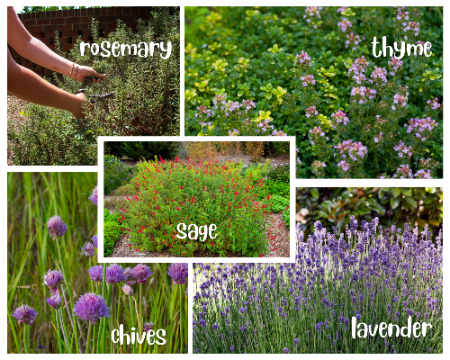Edible Landscaping: Growing Your Own Herbs
Having a beautiful garden and eating it too is easily accomplished with herbs. When choosing herbs to add to the landscape, there are several things to consider.
To get started, why not choose herbs to grow that you currently use when cooking?

Gardening success begins with choosing the right plant for the right spot!
Just like with flowers, herbs come as annuals or perennials, evergreen or deciduous. Knowing something about your site and the conditions the herbs prefer will make your garden more successful.
- What is the soil drainage like?
- What other plants will be in the same flower beds?
- When inter‐ planting, group plants together that need the same conditions.
- You don’t want to water or fertilize each plant individually, but treat the bed as one unit.
- While many herbs prefer full sun, many can also take partial shade.
- Keep in mind that we rarely use any chemicals on herbs.
- Don’t plant herbs near plants that you regularly spray with fungicides, insecticides and herbicides.
- If you are using the herbs as double‐duty plants, both for beauty and in the kitchen, then you also need to consider their attractiveness in the landscape.
Starting out with herbs? Grow easy ones first.
If you are new to gardening, then start small and add more as you gain confidence. Some easy ones to start with include chives.
Chives
Chives are a member of the onion family and two forms are commonly grown in the home landscape. Onion chives Allium schoenoprasum produces tufts of grass like foliage topped with beautiful clusters of purple flowers. It is much better behaved than its cousin the garlic chive Allium tuberosum with flat foliage covered in white clusters of blooms in late summer. Every flower forms a seed head full of black seeds, and most of those seeds germinate, so it can become invasive. You can eat the foliage and flowers of both plants quite nicely. They make a great garnish with a hint of onion or garlic flavor. The bees love the blooms on both plants.
Rosemary
Rosemary is a very popular evergreen plant for dry, poor sites. It doesn’t tolerate heavy, clay soils. It is drought tolerant and usually pretty carefree. The 2014 and 2015 winters took their toll and many people lost branches, but rosemary is thriving this season. From upright Rosemary officinalis to cascading or prostrate forms Rosmarinus officinalis prostratus, rosemary has a gray‐green foliage and lovely lavender flowers in the late winter into spring.
Thyme
Thyme makes a lovely groundcover and comes in several different foliage forms with green, yellow, silver and white variegation. Thymus vulgaris or common thyme has lovely pink or purple blooms. The lemon thyme Thymus citriodorus has a wonderful lemon scent and comes in variegated or yellow forms. And creeping thyme Thymus serpyllum make a great amendment to plant around stepping stones in the garden. Thyme can be used in containers or in the ground. Like rosemary, it likes it on the dry side.
Lavender
Lavender (Lavandula) is a great perennial that can be a bit finicky until it finds the right spot. This Mediterranean native with gray‐green foliage again indicates its love of a dryer, poorer site. It has fragrant spikes of blue to purple blooms. ‘Hidcote’ and ‘Munstead’ are two of the hardiest and best loved lavender varieties.
Sage
Culinary sage (Salvia officinalis) is in the salvia family which is a huge family of plants. Our culinary sage is evergreen and there are varieties with gray‐green leaves, some with purple, white and green leaves and others with yellow and green variegation. The culinary sage plant also has light purple blooms in early spring. The pineapple sage Salvia elegans is a showstopper in the fall with pineapple fragranced foliage and fire engine red blooms. They are great perennials for the garden in full sun to partial shade, as are the other more ornamental members of the salvia family, that aren’t used in cooking.
The above herbs are perennials and for the most part evergreen.
You can also grow annual herbs in with your flowers including numerous varieties of basil, dill and nasturtiums. Beware of the perennial oregano and mint, as they can take over a garden. If you want to grow these herbs, consider growing them in containers to contain their spread.
Many herbs are easy plants to grow in the garden, if you know something about their needs. Some prefer dry sites, like catmint, lavender, rosemary, and thyme, while others like basil, salvia and monarda like even moisture. So do your homework and choose the right plants for your site, and not only will they be beautiful, but useful plants in the garden.
For more help with getting started with an edible landscape, contact your local county agent.